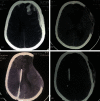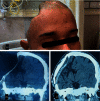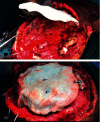Sinking Skin Flap Syndrome following Posttraumatic Hydrocephalus
- PMID: 33628544
- PMCID: PMC7886569
- DOI: 10.1155/2021/6682310
Sinking Skin Flap Syndrome following Posttraumatic Hydrocephalus
Abstract
Introduction: Complications following craniotomy are not uncommon and Sinking Skin Flap Syndrome (SSFS) constitutes a rare entity that may present after a large Decompressive Craniectomy. Although the entity is widely reported, the literature mostly consists of case reports. Authors present a case series of three patients with review of literature highlighting the various factors which can prove therapeutic and can help in avoidance of complications.
Materials and methods: The study was conducted over a period of 3 years, from 2016 to 2019, and included 212 patients who underwent unilateral Decompressive Craniectomy (DC) for trauma in our institute. All 212 patients underwent a similar DC following a strict institutional protocol and the craniectomies were performed by the same surgical team. At total of 160 patients survived and elective cranioplasty was planned at a 3-month interval. Out of a total of 160 patients who survived, 38 developed hydrocephalus, 3 patients presented with hydrocephalus acutely and had to be shunted before cranioplasty and underwent ventriculoperitoneal (VP) shunting on the opposite side of craniectomy. All 3 of these patients developed SSFS and were the focus of this case series wherein review of literature was done with emphasis being laid on the salient features towards management of SSFS in such precranioplasty shunted patients. These 3 patients were treated via rehydration using normal saline (NS) till the Central Venous Pressure (CVP) equaled 8-10 cm of water, nursing in Trendelenburg position and shunt occlusion using silk 3-0 round bodied suture tied over a "C"-loop of VP shunt tube over clavicle. This was followed by cranioplasty within 2 days of presentation using a flattened, nonconvex artificial Polymethyl Methacrylate (PMMA) bone flap with central hitch suture taken across the bone flap and release of shunt tie in immediate postoperative period. The PMMA bone flap was made intraoperatively after measuring the defect size accurately after exposure of defect. 3D printing option was not availed by any patient considering the high cost and patients' poor socioeconomic status.
Results: Out of a total of 212 patients, thirty-eight patients (19%) developed posttraumatic hydrocephalus and out of 38, three presented with SSFS over the course of time. Two patients presented with hemiparesis of the side opposite to sunken flap while 1 other patient was brought by relatives in stuporous state. All 3 were subjected to VP shunt tie, rehydration, and cranioplasty using flattened artificial bone flap and showed gradual recovery in postoperative period without any complications.
Conclusion: Various factors like nursing in Trendelenburg position, adequate rehydration, early cranioplasty after resolution of oedema, preoperative tying of VP shunt and its subsequent release in immediate postoperative period, use of flattened PMMA bone flaps, placement of a central dural hitch suture across the bone, and a preoperative central burr hole in the bone flap may accelerate healing and, in most cases, reversal of sensory-motor deficits along with reduction in complication rates.
Copyright © 2021 Ashish Chugh et al.
Conflict of interest statement
The authors declare that they have no conflicts of interest.
Figures




Similar articles
-
Sinking skin flap syndrome in a patient with bone resorption after cranioplasty and ventriculoperitoneal shunt placement: illustrative case.J Neurosurg Case Lessons. 2021 Sep 13;2(11):CASE21359. doi: 10.3171/CASE21359. eCollection 2021 Sep 13. J Neurosurg Case Lessons. 2021. PMID: 35855302 Free PMC article.
-
Importance of Early Cranioplasty in Reversing the "Syndrome of the Trephine/Motor Trephine Syndrome/Sinking Skin Flap Syndrome".J Maxillofac Oral Surg. 2015 Sep;14(3):666-73. doi: 10.1007/s12663-014-0673-1. Epub 2014 Aug 12. J Maxillofac Oral Surg. 2015. PMID: 26225060 Free PMC article.
-
Simultaneous cranioplasty and ventriculoperitoneal shunt placement in patients with traumatic brain injury undergoing unilateral decompressive craniectomy.J Clin Neurosci. 2020 Sep;79:45-50. doi: 10.1016/j.jocn.2020.07.015. Epub 2020 Aug 5. J Clin Neurosci. 2020. PMID: 33070916
-
Sinking bone flap due to overdrainage of a ventriculoperitoneal shunt. A case report and review of the literature.Neurocirugia (Engl Ed). 2023 Jul-Aug;34(4):208-212. doi: 10.1016/j.neucie.2022.11.024. Epub 2023 Feb 10. Neurocirugia (Engl Ed). 2023. PMID: 36775741 Review.
-
Revisiting sinking skin flap syndrome: a series of case reports and literature review on cranioplasty with PEEK implants.Neurol Res. 2025 Feb;47(2):147-153. doi: 10.1080/01616412.2024.2448632. Epub 2025 Jan 19. Neurol Res. 2025. PMID: 39828946 Review.
Cited by
-
Sunken flap following chest tube placement in the presence of ventriculopleural shunt: a case report.J Med Case Rep. 2024 Dec 25;18(1):609. doi: 10.1186/s13256-024-04963-9. J Med Case Rep. 2024. PMID: 39719649 Free PMC article.
-
Catastrophic Propeller Brain Injury with Large Scalp Defect Treated with Omental Flap.NMC Case Rep J. 2023 Apr 21;10:103-108. doi: 10.2176/jns-nmc.2022-0321. eCollection 2023. NMC Case Rep J. 2023. PMID: 37197283 Free PMC article.
-
Sinking skin flap syndrome in a patient with bone resorption after cranioplasty and ventriculoperitoneal shunt placement: illustrative case.J Neurosurg Case Lessons. 2021 Sep 13;2(11):CASE21359. doi: 10.3171/CASE21359. eCollection 2021 Sep 13. J Neurosurg Case Lessons. 2021. PMID: 35855302 Free PMC article.
References
Publication types
LinkOut - more resources
Full Text Sources
Other Literature Sources
Miscellaneous

